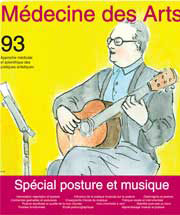Arts Medicine Journal N°93 Posture and Music

Arts Medicine Journal N°93 Posture and MusicArtists' health, musician's health
Issue 93 Posture and Music
Medical and scientific approach to artistic practices
Free Shipping
The articles of the journal are not sold independently, the price of 17 euros corresponds to the price of the whole magazine, all articles and chronicles.
Breathing is involved in the maintenance of posture. What are the interrelationships between posture and breathing in musicians and singers is the subject of this first article. Do musical practices induce certain postural patterns that can be found outside of musical practice, and do music teachers, through their own posture at the instrument, influence the postural patterns of their students? The profession of music teacher has rarely been studied in terms of their health, what are the gestural and psycho-organisational constraints specific to the profession of music teacher, what are the risks of musculoskeletal disorders, what is the influence of their working conditions on their health? In this issue you will find other sections on the health of musicians and singers and posture.
Edito Arts Medicine N°93
The link between breathing and posture. Relevance to musical practice
AbstractThe diaphragm, in addition to being the primary breathing muscle, is a structure that plays multiple roles. In particular it plays a role in posture control and is an important factor in the anticipatory stabilization of the torso. This link between posture and breathing has been demonstrated in a number of studies and is of particular significance for wind instrument musicians and singers, for which sound production can be seen as a specific balance mechanism between the inspiratory muscles and expiratory muscles according to desired sound parameters. Postural stability is a key factor in ensuring the quality of a musician’s performance. The link between posture and breathing merits consideration in the preventive or therapeutic care of a musician.
The influence of musical practice on posture.
AbstractThe objective of this study is to identify the similarities and differences in posture of beginner students during the course of their training, in relation to the postures observed in the teachers, according to the type of music practice.
This posturographic study was conducted on a population of 19 music teachers and 42 beginner students, in the following disciplines: drumming, singing, keyboard, guitar and bass guitar. The results demonstrate for each musical practice a change in the posture of the students towards the postural characteristics of the teachers. The results confirm that there are certain unbalanced postural patterns in musicians, of functional origin, outside of the music performance situation, which can be provoked by instrumental playing postures.
This reaffirms the importance that should be given to physiology during training and highlights the need for musculoskeletal rebalancing outside instrumental playing situation to reduce the impact of postural misalignments relating to such practice.
Gestural, postural and psycho-organisational constraints of the music school teachers
AbstractWell-known musculoskeletal disorders widely documented in music professionals, have not however been studied extensively in music school teachers. The latter in fact have postural and psycho-organisational constraints that differ from other musicians. The objective of the study is to carry out an overview of musculoskeletal disorders of the upper limb and spine in music school teachers in local communities (in France), as well as an assessment of the gestural, postural and psycho-organisational constraints associated with their activity.
Teachers from three music schools in the Isère region were invited to participate in the study and 44 music school teachers were interviewed based on a questionnaire adapted to the work method established by the European consensus group Saltsa on musculoskeletal disorders. Lastly the study of the workstation of eight teachers practicing different musical instruments, observed during music lessons, allowed for the identification of gestural and postural constraints specific to the teaching of an instrument.
As regards musculoskeletal disorders over the last twelve months, 88.6% of the teachers questioned had experienced or were experiencing pain in the upper limbs or spine. The assessment of psycho-organisational constraints revealed a workload considered to be “heavy” or “very heavy” for 63.6% of the teachers, self-reliance, recognition for their work, support from colleagues and management, but with disparities according to status. Multi-site non-tenured teachers, teaching for over 20 hours a week expressed a more negative view.
Balanced posture and singing voice quality
AbstractWhat are the repercussions of an unbalanced posture on vocal quality? Professional singers, although attentive to the quality of the singing voice, still do not perceive the impact on their voice of adopting certain unbalanced postures
Scapular dyskinesia in instrumental musicians
AbstractAwareness of correct posture and scapula position should be integrated into musical learning and practice. A static and dynamic malpositioning of the scapula should be systematically investigated in the young musician.
Postures and musculoskeletal pain in guitarists
AbstractSeveral risk factors related to playing habits should be taken into account by the guitarist in order to prevent musculoskeletal disorders. Ergonomic redesign of tasks and improvement of personal habits could reduce biomechanical stresses and reduce risks.
Portrait of the artist as a worker No. 93
Musicians in your dreams
AbstractThe relationship between music, dreams and creativity are investigated in this study. New musical productions could be created in the musicians' dreams.
Version papier
17€
Subscription, France, EEC (1 year, 2 issues)
34€
Subscription Outside EEC (1 year, 2 issues)
37€
Les garanties médecine des arts
Articles en stock
Envoi dans les 24h
Paiement
en ligne sécurisé
Une question ?
